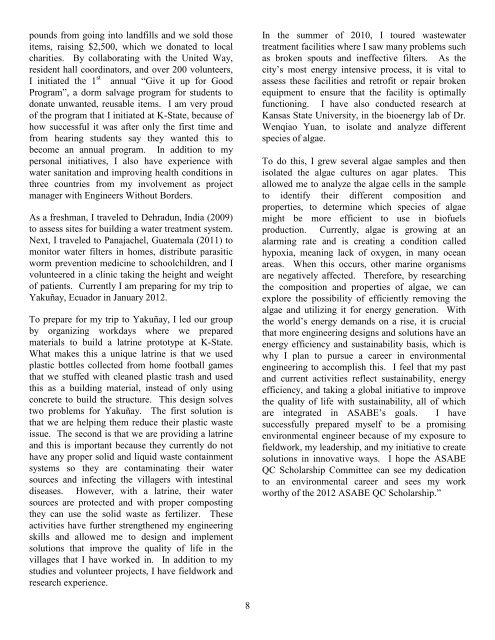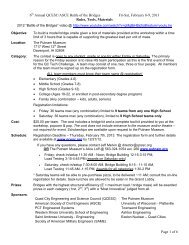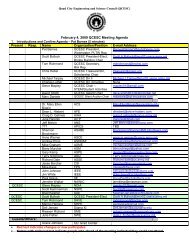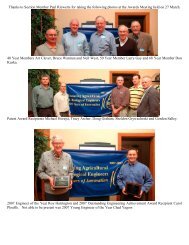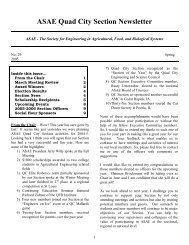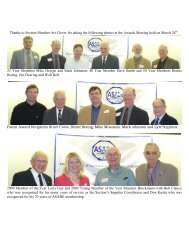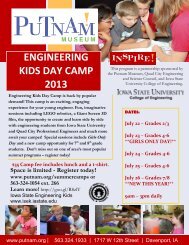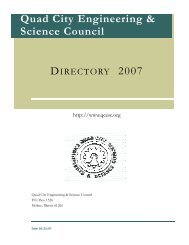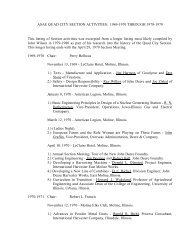Spring 2012 - Quad City Engineering and Science Council
Spring 2012 - Quad City Engineering and Science Council
Spring 2012 - Quad City Engineering and Science Council
Create successful ePaper yourself
Turn your PDF publications into a flip-book with our unique Google optimized e-Paper software.
pounds from going into l<strong>and</strong>fills <strong>and</strong> we sold those<br />
items, raising $2,500, which we donated to local<br />
charities. By collaborating with the United Way,<br />
resident hall coordinators, <strong>and</strong> over 200 volunteers,<br />
I initiated the 1 st annual “Give it up for Good<br />
Program”, a dorm salvage program for students to<br />
donate unwanted, reusable items. I am very proud<br />
of the program that I initiated at K-State, because of<br />
how successful it was after only the first time <strong>and</strong><br />
from hearing students say they wanted this to<br />
become an annual program. In addition to my<br />
personal initiatives, I also have experience with<br />
water sanitation <strong>and</strong> improving health conditions in<br />
three countries from my involvement as project<br />
manager with Engineers Without Borders.<br />
As a freshman, I traveled to Dehradun, India (2009)<br />
to assess sites for building a water treatment system.<br />
Next, I traveled to Panajachel, Guatemala (2011) to<br />
monitor water filters in homes, distribute parasitic<br />
worm prevention medicine to schoolchildren, <strong>and</strong> I<br />
volunteered in a clinic taking the height <strong>and</strong> weight<br />
of patients. Currently I am preparing for my trip to<br />
Yakuñay, Ecuador in January <strong>2012</strong>.<br />
To prepare for my trip to Yakuñay, I led our group<br />
by organizing workdays where we prepared<br />
materials to build a latrine prototype at K-State.<br />
What makes this a unique latrine is that we used<br />
plastic bottles collected from home football games<br />
that we stuffed with cleaned plastic trash <strong>and</strong> used<br />
this as a building material, instead of only using<br />
concrete to build the structure. This design solves<br />
two problems for Yakuñay. The first solution is<br />
that we are helping them reduce their plastic waste<br />
issue. The second is that we are providing a latrine<br />
<strong>and</strong> this is important because they currently do not<br />
have any proper solid <strong>and</strong> liquid waste containment<br />
systems so they are contaminating their water<br />
sources <strong>and</strong> infecting the villagers with intestinal<br />
diseases. However, with a latrine, their water<br />
sources are protected <strong>and</strong> with proper composting<br />
they can use the solid waste as fertilizer. These<br />
activities have further strengthened my engineering<br />
skills <strong>and</strong> allowed me to design <strong>and</strong> implement<br />
solutions that improve the quality of life in the<br />
villages that I have worked in. In addition to my<br />
studies <strong>and</strong> volunteer projects, I have fieldwork <strong>and</strong><br />
research experience.<br />
In the summer of 2010, I toured wastewater<br />
treatment facilities where I saw many problems such<br />
as broken spouts <strong>and</strong> ineffective filters. As the<br />
city’s most energy intensive process, it is vital to<br />
assess these facilities <strong>and</strong> retrofit or repair broken<br />
equipment to ensure that the facility is optimally<br />
functioning. I have also conducted research at<br />
Kansas State University, in the bioenergy lab of Dr.<br />
Wenqiao Yuan, to isolate <strong>and</strong> analyze different<br />
species of algae.<br />
To do this, I grew several algae samples <strong>and</strong> then<br />
isolated the algae cultures on agar plates. This<br />
allowed me to analyze the algae cells in the sample<br />
to identify their different composition <strong>and</strong><br />
properties, to determine which species of algae<br />
might be more efficient to use in biofuels<br />
production. Currently, algae is growing at an<br />
alarming rate <strong>and</strong> is creating a condition called<br />
hypoxia, meaning lack of oxygen, in many ocean<br />
areas. When this occurs, other marine organisms<br />
are negatively affected. Therefore, by researching<br />
the composition <strong>and</strong> properties of algae, we can<br />
explore the possibility of efficiently removing the<br />
algae <strong>and</strong> utilizing it for energy generation. With<br />
the world’s energy dem<strong>and</strong>s on a rise, it is crucial<br />
that more engineering designs <strong>and</strong> solutions have an<br />
energy efficiency <strong>and</strong> sustainability basis, which is<br />
why I plan to pursue a career in environmental<br />
engineering to accomplish this. I feel that my past<br />
<strong>and</strong> current activities reflect sustainability, energy<br />
efficiency, <strong>and</strong> taking a global initiative to improve<br />
the quality of life with sustainability, all of which<br />
are integrated in ASABE’s goals. I have<br />
successfully prepared myself to be a promising<br />
environmental engineer because of my exposure to<br />
fieldwork, my leadership, <strong>and</strong> my initiative to create<br />
solutions in innovative ways. I hope the ASABE<br />
QC Scholarship Committee can see my dedication<br />
to an environmental career <strong>and</strong> sees my work<br />
worthy of the <strong>2012</strong> ASABE QC Scholarship.”<br />
8


